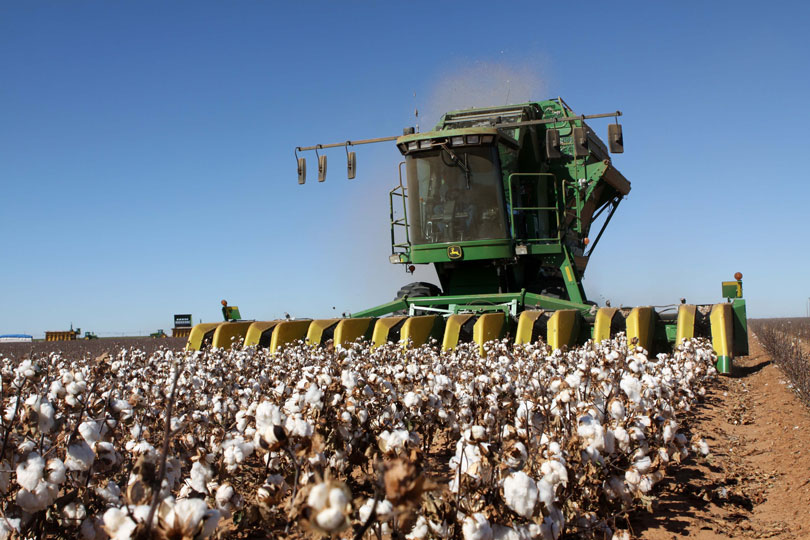U.S. cotton farmers intend to plant 13.1 million cotton acres this spring—up 3.7 percent from 2017, according to the National Cotton Council’s (NCC) 37th annual Early Season Planting Intentions Survey.
Upland cotton intentions are up 3.8 percent from last year to 12.8 million acres. Extra-long staple intentions represent a 1 percent increase to 254,000 acres.
“Planted acreage is just one of the factors that will determine supplies of cotton and cottonseed. Ultimately, weather, insect pressures and agronomic conditions play a significant role in determining crop size,” Dr. Jody Campiche, NCC vice president of Economics and Policy Analysis said at the organization’s annual meeting in Fort Worth.
The Cotton Belt’s harvested area totals 11.1 million acres with abandonment assumed at about 15 percent. Using an average U.S. yield per harvested acre of 842 pounds generates a cotton crop of 19.4 million bales, with 18.7 million upland bales and 744,000 extra-long staple bales.
The NCC survey was mailed in mid-December 2017 to farmers across the 17-state Cotton Belt, and responses were collected through mid-January. The survey asked farmers for the number of acres devoted to cotton and other crops in 2017 and the acres planned for the coming season.
“History has shown that U.S. farmers respond to relative prices when making planting decisions. During the survey period, cotton futures prices were stronger relative to competing crops. The price ratios of cotton to corn and soybeans are more favorable than in 2017,” Campiche said. “However, soybeans are expected to provide competition for available acres in 2018 due in part to the lower production costs relative to cotton. While cotton prices have improved relative to other crops, cottonseed prices are at the lowest level since the 2006 marketing year, thus increasing the net costs of ginning.”
Southwest
Southwest growers intend to plant 8 million acres of cotton, an increase of 5.7 percent. Increases in cotton area are expected in each of the three states.
Texas cotton acreage, according to the survey, is expected to increase by 3.7 percent, as respondents expect to plant more wheat and less corn and “other crops.”
In Kansas, farmers intend to plant 55.3 percent more cotton acres, along with more wheat and “other crops.” Kansas growers intend to plant less corn and soybeans. In Oklahoma, a 21 percent increase in cotton acreage is expected as wheat acreage declines and “other crops” increase slightly.
Southeast
Survey respondents in the Southeast indicate a 2.3 percent increase in the region’s upland area to 2.6 million acres. All six states show an increase in acreage.
In Alabama, the survey responses indicate 0.8 percent more cotton acreage and less wheat, soybeans and “other crops.” In Florida, respondents indicated more cotton and soybeans and less “other crops.” In Georgia, cotton acreage is expected to increase by 0.6 percent, as growers expect to plant fewer soybeans and more corn and “other crops,” likely peanuts. In North Carolina, an 8.2 percent increase is expected as acreage moves away from soybeans. In South Carolina, cotton acreage is expected to increase by 3.4 percent, while corn acreage is expected to decline. Cotton acreage is expected to increase by 3.1 percent in Virginia, as acreage moves away from wheat and “other crops.”
Mid-South
In the Mid-South, growers have demonstrated their ability to adjust acreage based on market signals. The relative prices and potential returns of competing crops play a significant role in cotton acreage. Mid-South growers intend to plant 1.9 million acres, a decrease of 0.1 percent from the previous year as some land is shifted to soybeans.
Across the region, Louisiana and Mississippi intend to decrease cotton acreage and Arkansas, Missouri and Tennessee expect to increase acreage. The largest decline was reported in Mississippi with 5.5 percent less cotton acreage in 2018. In Tennessee, cotton acreage is expected to increase by 1.5 percent as land shifts away from corn and wheat. Missouri growers expect to increase cotton acres by 3.8 percent and plant less corn and soybeans. In Louisiana, respondents intend to plant 2.6 percent less cotton acreage, more soybeans, and less of all “other crops.”
All states in

